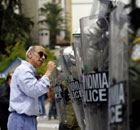-
-
China Daily E-paper
World
Drone attacks in Pakistan to car bomb in NYC
By Chen Weihua (chinadaily.com.cn)
Updated: 2010-05-04 09:46
 |
Large Medium Small |

A NYPD officer in an bomb suit examines a Nissan Pathfinder sport utility vehicle parked in New York's Times Square May 1, 2010. An apparent failed car bomb that was smoking and emitted a "flash" in a sport utility vehicle sparked an evacuation of New York's Times Square on Saturday night as authorities worked to dismantle the device during Broadway's peak period. [Photo/Agencies]
The events of the last few days in New York's Times Square and the northwest Pakistan's tribal area of North Waziristan provide a clue why we live in a world much less safer than before.
After a failed car bombing in the Times Square on Saturday evening, many people going there, for work, sightseeing or Broadway musicals, might no longer feel as relaxed as before. In our minds, something seriously disturbing might occur.
No one knows who the suspected man in the released video was although the Taliban in Pakistan has claimed responsibility.
In another event on Monday, at least six people were killed in a suspected US drone attack in northwest Pakistan's tribal area of North Waziristan, Xinhua News Agency quoted local sources as saying.
The drone attacks, conducted by pilotless aircraft and adopted by US military in Afghanistan and Pakistan since 2004, have killed between 898 and 1,336 individuals, of whom around 609 to 958 were described as militants in reliable press accounts. The true civilian fatality rate is about 30 percent, according to the Washington-based New America Foundation.
Reports from some other sources have described a much higher civilian fatality rate. Some claimed that for every militant killed, there were 50 civilian deaths.
Although the exact figures may still to be determined, the high civilian casualties would already qualify the drone attack as a kind of assassination, a kind of massacre or an indiscriminative attack on militants and civilians alike. Already the United Nations human rights investigator Philip Alston, also a New York University professor, said he is worried that the drones are being operated in a framework which may well violate international humanitarian law and international human rights laws.













